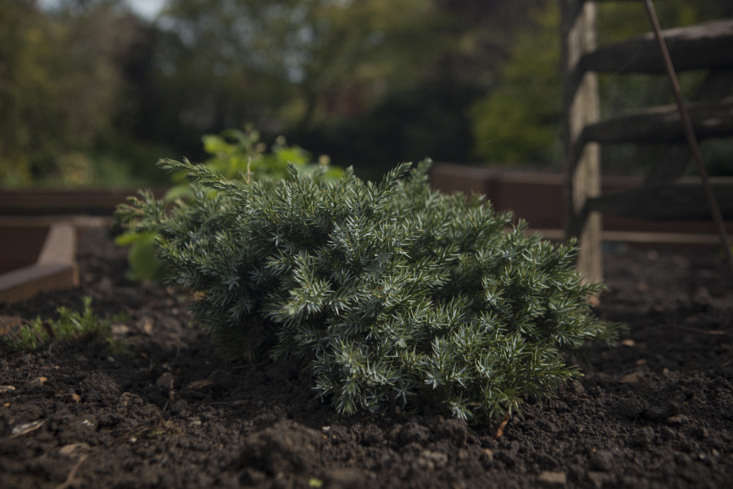It is no longer possible to order a simple gin and tonic in a country pub in Northamptonshire, England. Instead, the bartender demands more detail; there are decisions to be made. Are you looking for a sloe gin with lemon tonic water, or perhaps a pink gin that is 34 percent rhubarb? In the UK, everyone is a gin expert these days—are you?
For an East Midlander such as myself, there is no excuse for ignorance: there are craft distillers in our midst. The first of its kind in Northamptonshire, Warner Edwards Gin will be re-creating a version of its natural setting—a 200-year old farm in Northamptonshire—at the Chelsea Flower Show this year. As a local, I will try to explain how the essence of this quiet county could translate into a show garden (with an update next week: the Royal Horticultural Society’s annual Chelsea Flower Show runs from May 22 to 26).
Photography by Jim Powell for Gardenista.

Behind the barn doors of Falls Farm near Kelmarsh Hall, a giant copper still from Germany is fed with spring water from a sloping field across the street. The land is distinguished by medieval terracing, dramatic landforms left over from a manorial seat that, in turn, had been built on the site of a priory, run by the Knights Hospitaller. The religious and military order fished from a series of rectangular ponds, their outlines still visible, among an abundance of springs.

The sophisticated flavors of Warner Edwards, proffered at Fortnum & Mason, Harvey Nichols Food Hall, and the like, have country ingredients, the kind of thing that the Women’s Institute would use for flavoring jellies or cordials. There is elderflower, sloe, rhubarb, and honey gin. There is even a gin flavored with lemon balm (“Melissa”), that runaway herb that bees love and people confuse with mint. These are real flavors; gin bottles are sold with seed packets.

Northamptonshire (and neighboring Leicestershire and Rutland) are barely known outside of the Midlands, preferring to keep to themselves. Although the Civil War was intensely fought here, it is a quiet place made up of farms and manors, connecting the fields like the giant fox hunting map that it essentially is. Hunting is pivotal; although the connection is generally denied, the jumpable hedges are beautifully maintained, the best examples trimmed like a pitched roof.

Northamptonshire also has an abundance of laid hedges, in which blackthorn (which produces sloe berries), elder, and whatever else has made itself at home on the boundaries, is bent over at an unlikely angle, to form beautiful, impenetrable perimeters. These hedgerows of Northamptonshire have inspired Warner Edwards’s botanical gins, and hawthorn will feature in the Chelsea garden.

Like all the Warner Edwards flavors, Honeybee Gin sounds almost health-giving. With every dose of the good stuff, a percentage of proceeds go to the Royal Horticultural Society, which is run as a charity. Tom Warner, co-partner, and the Warner Edwards bee expert Jonny Easter are working with the RHS gardens at Wisley to create a new bee-attracting heather garden.

The show garden at Chelsea (in the Artisan section) is designed by Kate Savill and Tamara Bridge. Their plant choices for the Warner Edwards garden focus on the edible, botanical, or wildlife friendly. Expect to see dandelions but also many representatives of the Lamiaceae family, considered to be the most important plant family for pollinators. It includes not only Melissa officinalis but mint (shown), lavender, rosemary, thyme, and basil, with wild oregano flowers arguably the most popular for bees.

Several acres in the neighboring village of Arthingworth are in the process of being converted into wildflower meadows as part of this bee initiative, with the distiller’s hive count on the increase.

A small walled garden at Falls Farm, once tended by Tom Warner’s late mother Adele, has formed part of the inspiration for the Chelsea garden. It is planted with a smattering of gin ingredients, including the most important one: juniper (shown). The quantities found in this garden limit their use to recipe development and inspiration for visitors, but the longterm vision for this young and successful company is that native ingredients are grown on the farm.

Many of the flavors that make botanical gin interesting (coriander, cinnamon, nutmeg, cardamon) are from far-flung places and will continue to be imported. The rock and water on which Falls Farm is built (there are several farms in the center of the village) have combined with rural culture and a healthy ambition to turn this distillery into an amazing success story, given that the venture only began in 2012. Taking it to a garden-mad audience at Chelsea is a jolly good idea.
Follow our coverage of this year’s Chelsea Flower Show as Kendra reports on the behind-the-scenes drama and makes the rounds of the show gardens.
See more tips for planting A Garden that Grows Cocktails, and find out how to grow our favorite aromatic Herbs (including Lemon Verbena, Mint, and Rosemary) in our curated Garden Design 101 guides.








Have a Question or Comment About This Post?
Join the conversation